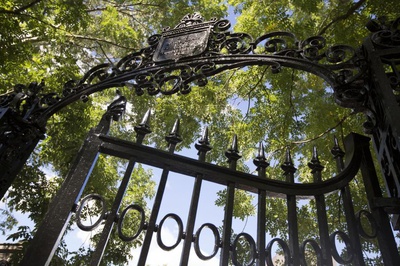
News
News Flash: Memory Shop and Anime Zakka to Open in Harvard Square

News
Harvard Researchers Develop AI-Driven Framework To Study Social Interactions, A Step Forward for Autism Research

News
Harvard Innovation Labs Announces 25 President’s Innovation Challenge Finalists

News
Graduate Student Council To Vote on Meeting Attendance Policy

News
Pop Hits and Politics: At Yardfest, Students Dance to Bedingfield and a Student Band Condemns Trump
Artist Profile: Sky Hopinka on Telling Indigenous Stories in the 21st Century

Sky Hopinka, assistant professor in Harvard’s Art, Film, and Visual Studies department, is an experimental Indigenous filmmaker from the Ho-Chunk Nation. At the core of his work is a profound commitment to storytelling through his Indigenous perspective, a narrative that has been long marginalized within the Western canon.
“The thing that I hope audiences take away is that this cinema that I’m interested in making isn’t necessarily one that excludes anyone,” Hopinka said in an interview with The Crimson. “It’s one that has boundaries and codes within it that may not be accessible to everyone. And as long as you know there is something there, even if you don't know what it is, I hope that that’s a way to also draw some sort of meaning that is related to their own experience.”
Instead of focusing on educating non-Indigenous people about their culture — a role often imposed on Indigenous films by Western audiences — Hopinka’s work challenges viewers to embrace the discomfort of not knowing. This discomfort is a fundamental aspect of engaging with and confronting another culture. By doing so, his work encourages viewers to find solace in uncertainty and to seek meaningful connections through shared experience.
Hopinka’s filmmaking is deeply influenced by his upbringing in multiple Tribal communities and his dual heritage from two Tribal Nations. His mother, an enrolled member of the Pechanga Band of Luiseño Indians in California, and his father, an enrolled member of the Ho-Chunk Nation, raised him near the Lumni Reservation in Ferndale, Washington — a small, predominantly white farming town. With his mother a dancer and his father a drummer on the powwow circuit, Hopinka was immersed in Indigenous cultures throughout his childhood.
“At a very early age I was taught these cultural boundaries and lines of respect that aren’t often respected by an anthropologist or white people that would lump us all together in one homogenous pot of Nativeness,” Hopinka said.
Hopinka’s background has undoubtedly influenced his approach to filmmaking. Though he didn’t start his film career until later in life, he often carried a handheld Sony Powershot camera, capturing snippets of the world around him. At the age of 27, he used it to create his first short film, documenting himself and friends building a traditional fishing dam on the Columbia River. His early work was revolutionary in its portrayal of Indigenous people living in the present and actively engaging with their culture. It was simple yet powerful, conveying the beauty of connecting to one’s heritage without the need for words to explain its significance.
Hopinka discussed his work with a profound sense of humility, reflecting his earlier realization that he learned to navigate cultural boundaries with care and respect.
“Where I have been at has been trying to resist any sort of label or any sort of impulse by anyone to paint myself as an authority. And I think it’s that extension, that idea of the authority is really important, especially in making work that is about very tribally specific things,” he said.
To watch Hopinka’s work and come away with the interpretation that he is speaking for the experience of all Indigenous people would be a mistake. Instead, his perspective reflects a deliberate act of resistance, rejecting hierarchical narratives that homogenize Indigenous culture. By focusing on his personal experiences, Hopinka creates space for the multiple voices of Tribal Nations.
In 2016, Hopinka furthered this vision by creating the film program “What Was Always Yours And Never Lost,” a space dedicated for Indigenous artists in the experimental film world to collaborate and foster dialogue.
Hopinka explained his source of inspiration in naming his film program.
“So often the things that have been lost have been defined by people outside of their community,” he said. “And certain things that speak to how Native people continue to exist today that is not in deficit to who we were 100 years ago.”
An inspiring aspect of Hopinka’s work is the creation of something new — an expression of Indigenous identity no longer defined by external forces but shaped by the community itself.
“There is a living part of the culture that should account for the sense of change and growth,” he said. “Try to re-engage with things in the past and bring them back but also think about what you want to leave behind.”
Far too often, Indigenous narratives are historicized, limiting their relevance to the present. By failing to look forward, Indigenous cultures risk erasure since future generations may not see their heritage as a dynamic part of today’s world. This is why Hopinka’s work is so vital to Indigenous communities; he focuses on the contemporary, advancing important discussions of Indigeneity and bringing attention to the evolving experiences of Indigenous peoples.
Hopinka reflected on his experience as an Indigenous film professor at Harvard.
“It’s something that I continue to navigate, to question, to think about,” he said.
When discussing Harvard’s complicated relationship with Indigenous peoples, Hopinka addressed a range of issues — from Harvard’s fraught history in problems like complying with the Native American Graves Protection and Repatriation Act (NAGPRA) and the human remains and cultural artifacts housed at the Peabody Museum to the history of Native American slavery and the genocide on the very land on which Harvard now stands.
Hopinka’s response to these issues is simple.
“The best thing to respond to where I am at is to make things,” he said.
Through film and collaborative works, Hopinka and fellow Indigenous artists foster essential conversations that strengthen their communities. Their work creates spaces for shared reflection and collective growth while drawing attention to issues affecting Indigenous people. In doing so, they broaden the dialogue on Indigenous identity, inspiring and empowering the next generations of Indigenous people.
—Staff writer LeMonie K. Hutt can be reached at lemonie.hutt@thecrimson.com.
Want to keep up with breaking news? Subscribe to our email newsletter.
Most Read
- Experts Say Harvard Has a Strong Case in Legal Battle Against Trump
- College Dean Rakesh Khurana Declines To Say How Harvard Will Respond to Homeland Security Demands
- Amid Feud With Trump, Harvard Pushed Back Release of Antisemitism, Anti-Muslim Bias Task Force Reports From Early April
- Trump’s Harvard Simply Isn’t Real
- Harvard Asks Judge to Expedite Lawsuit Against Trump Admin, Declines to Request Emergency Injunction
From Our Advertisers

Over 300+ courses at prestigious colleges and universities in the US and UK are at your disposal.

Where you should have gotten your protein since 1998.

Serve as a proctor for Harvard Summer School (HSS) students, either in the Secondary School Program (SSP), General Program (GP), or Pre-College Program.

With an increasingly competitive Law School admissions process, it's important to understand what makes an applicant stand out.

Welcome to your one-stop gifting destination for men and women—it's like your neighborhood holiday shop, but way cooler.

HUSL seeks to create and empower a community of students who are seeking pathways into the Sports Business Industry.
